#fit india movement
Explore tagged Tumblr posts
Text
एथलेटिक्स दिवस पर युवाओं की दौड़ बनेगी तरुण संगठित चेतना का प्रतीक
बि��ौली में दौड़ेगा नया भारत: टीएससी यूथ क्लब के अध्यक्ष अमीर खान की अगुवाई में विश्व एथलेटिक्स दिवस पर जनांदोलन का रूप ले रहा एक स्थानीय आयोजन बिनौली (बागपत) दिनांक 06 मई 2025 — जब एक युवा खेल के मैदान में दौड़ता है तो वह केवल फिटनेस के लिए नहीं दौड़ता बल्कि उससे जुड़े होते हैं कई सामाजिक सरोकार और बेहतर भविष्य की उम्मीदें। फिटनेस को दिनचर्या का हिस्सा बनाने से हम न केवल स्वस्थ रहते हैं बल्कि…
#1600m Race#400m Race#800m Race#Amir Khan#Athletic Competition#Athletics#baghpat#Binoli#Community Event#Drug Abuse Awareness#Drug Free India#Drug Free Youth#Environment Awareness#Fit India Movement#Fitness Awareness#Fitness in Youth#Fitness Lifestyle#Healthy Lifestyle#Healthy Society#India Government#Local Sports Event#Mission LiFE#MY Bharat portal#Nehru Yuva Kendra#New Era World School#Social Awareness#social change#Sports Event#Sports for Social Change#TSC Youth Club
0 notes
Text
Fit India Movement : सीएम धामी के अधिकारियों को निर्देश, फिट इंडिया मूवमेंट के लिए बेहतर कार्ययोजना के साथ चलाया जाए अभियान
देहरादून : Fit India Movement प्लास्टिक मुक्त उत्तराखण्ड, स्वच्छता और फिट इंडिया मूवमेंट के लिए बेहतर कार्ययोजना के साथ अभियान चलाया जाए। इसमें जन जागरूकता के साथ ही जनसहभागिता की दिशा में विशेष प्रयास किये जाएं। यह निर्देश मुख्यमंत्री श्री पुष्कर सिंह धामी ने नई दिल्ली स्थित उत्तराखण्ड सदन से वर्चुअल बैठक के दौरान अधिकारियों को दिये। Mahakumbh Stampede : महाकुंभ में भगदड़ के बाद प्रशासन ने किए…
0 notes
Text
Jogging just 20–30 minutes a few times a week can significantly improve overall well-being.
#physiotherepist#physiotherapy#jogging#jogging Benefits#fitness#running#exercise#workout#physiotips#physio#Physio Vitals#Dr Ankita Sawant#Fit India Movement#Physiovitals#DrAnkitaSawant
0 notes
Text
I shared with this lady today that my fitness is non-negotiable and is a reflection of the strength of my spirit. I’m not on and off with working out nor do I work out to get ready for bikini season. I have worked out pretty much consistently for the last 20 years. That's because exercising my body is akin to breathing. It is one way I clear out the gunk from my mind and emotions which is liberation for my mental, emotional and spiritual health. It doesn't matter what happened the day before, I know that exercise, whether gym time, HIIT classes, pole dance, belly dance, aerial dance, pilates, running up hills, long walks in the city, climbing stadium stairs, or hot yoga fuels the life force pulsing and protruding through my body that makes me feel delicious in the best ways possible no matter what challenges I'm facing. Working out for me is not-optional. My ancestral mothers know that I am not meant to walk this earth disconnected from my body and feeling sluggish and incapable. Sculpting a strong back, a strong ass, strong legs, strong arms, strong feet, etc. are some of the most important parts of my spiritual practice. Said differently: Your body is truly the altar. Bless it with some offerings of fitness if movement is accessible for you. Allow these words to be your reminder to get up and get out. -India Ame'ye, Author
1K notes
·
View notes
Note
I saw how you said that describing the PRC as capitalist betrays a lack of understanding of capitalism and I actually really liked how well you explained that being against capitalism isn't proper Marxism/communism so I was wondering if you could open that post on understanding capitalism a bit more! Only if you're okay with it, of course!
Eventually I should do a real proper Effortpost on this with all the graphs and figures to really drive home the point that I'm making, but very briefly since it's getting late here:
In Marx's time, capitalism was an emergent societal mode of production that was closely entertwined with the enclosure movement and the industrial revolution. On the level of labor, it saw the decline of peasant and artisan labor and the rise of proletarianization, and with it the tendencies of mechanization and rationalization of production (e.g. de-skilling of manufacturing and measurement of efficiency by the labor-hour)
On a consistent historical level, from Marx's time to ours, capitalism has been characterized by the role of liquidity holders (e.g. banks, joint stock companies, investment funds &c) in investigating growth industries and investing in them for the purpose of greater profit. Notably: the demand from financial actors for returns on their balance-sheets is constant, regardless of the state of the development in any given productive market. Meanwhile the nature of industrial development is that it happens in fits and starts, in great surging advances followed by relatively stagnant plateaus. The results of this mismatch are twofold:
First, as Lenin chronicled, it leads for a demand to engage in imperialist expansion to open new markets and seek new profits that way. The other, arguably larger and more important frontier however is that of speculation. Because the inflation of the value of an asset creates purchasing power in and of itself in the short term, which is maintained on balance sheets so long as the arrears on credit derived on it keeps getting paid on a notional path to amortizaiton.
The tendency in capitalism since Marx's time has been the ever-growing importance of these two dynamics and the gradual receding of the importance of low-elasticity economic activity like manufacturing goods.
The tendency of imperialist expansion within capitalism has created a networked global bourgeoisie throughout the financial capitals of the world who extract rentier profits from the various rural peripheries of the global south, and the speculative nature of investment capital in the late 20th and early 21st century defines the quality of the "capitalist develpment" we see in bourgeois states in the contemporary global south: namely, extremely uneven development between rural and urban, trapping of the labor force in a holding-pattern of low-pay low-skill work such as textile production or low-end manufacturing (e.g. Bangladesh and Malaysia) while their capitals enjoy wealth near that of the imperial core, with relatively very high-paying jobs in the knowledge industries (this should ring a bell with India lol). Any country that is actually ruled by its bourgeoisie will follow this pattern, because financialized paper profits are larger (in nominal terms) than the highly investment-intensive industrial development that has gone on in the PRC under the stewardship of the Party. However the result is that the PRC has relatively low inequality among middle-income countries and the technological benefits of the industrialization led by cities is beginning to flow to rural China, which is what allowed them to lift 800 million people out of extreme poverty, something that has yet to happen in actually capitalist bourgeis states like India.
280 notes
·
View notes
Text
Reassigning the Main Six Ninja Weapons Because I Lowkey Hate Them
The more I watch Ninjago, the more I realize one thing: I hate the weapons assigned to the ninja. Like, LOATHE them.
So, to fix that, here's me reassigning the ninja weapons that fit their element/fighting style/overall vibes more!
Before I start, I will acknowledge that: a) Ninjago is meant to sell toy sets. I get it. The weapons were probably chosen off of what stereotypical ninja weapon looks coolest, and b) that being a Lego restricts what can be made (it’s hard to make Lego gauntlets the size of a minifigure. I get it.), and c) I’m insane and really enjoy the different types of premodern combat weapons the world has to offer and they probably thought people over the age of 11 wouldn’t get quite as invested into Ninjago as I would.
Anyways. Me being a hater outweighs all those disclaimers. This post is a little bit of an essay, so I put everything under the cut.
Cole: I'm starting with Cole because he is, by far, the WORST. He's the reason I made this post.
What screams "rocks, dirt, earth and superstrength" more than a scythe? Just about every other option! In the show, Cole barely even uses his scythe, opting to instead throw hands, which makes so much more sense for someone with SUPERSTRENGTH. Scythes are notoriously not actually weapons and are not good at being a viable weapon. They are hard to inflict damage with due to their limited range and shape of the blade, and the blade can be snapped off with enough force (which Cole has in spades). Piercing an enemy is difficult as the point of a scythe is curved and flat and very small, and very far away from the user so accuracy is also difficult. Big sweeping strikes are not optimal as they are easy to block or evade. If he was the elemental ninja of nature or plants or whatever, he'd get a pass for aesthetics because farmers use scythes.
The solution is to lean into Cole’s strength: strength. Give him gauntlets, like Vi from Arcane or Generator Rex. He's a close range brick shithouse, might as well make him even more of one. Other options for the “boxer on steroids” theme include push daggers (small knives designed for in-between the fingers) or, to really push home the "ninja" bit, give him Chinese deer horn knives.
But, gauntlets aren’t the only weapon associated with feats of strength. To keep with the original scythe having a handle, he could also be given a large hammer or axe, like Amy Rose or Hilda from Fire Emblem: 3 Houses. He’s big and strong and needs something that can handle-and dish out- that same power.
Jay: the second worst offender. He, to me, is the opposite of Cole- the unstoppable force to Cole's immovable object. He is based around speed and long range, and NUNCHAKU ARE ONLY ONE OF THOSE THINGS. It's also very difficult to conduct electricity with such a short weapon, when chain lightning is basically thee lightning attack.
Give him a chain whip (metal is a conductor, after all) or a rope dart. Something that can be thrown far and whipped around (WHIP? LIKE HIT SONG AND NINJAGO THEME WEEKEND WHI-). It’s also a very flashy and eye catching weapon that needs quite a bit of movement and precision to use, and I think it suits Jay’s personality well! He’s a very intelligent character and something that needs precision and maybe even calculations would fit him. Rope darts in particular are, well, as quick as lightning. Speed is his greatest ally, and the wide range and high flexibility allotted to him serves to only make his job easier.
Zane: Shuriken aren’t the worst thing, but they also don’t fit Zane. He's a versatile fighter when it comes to range and never uses his shuriken close-up since they’re typically used as throwing weapons and are too small to really be good at defensive maneuvers.
I would give him either a polearm or chakrams- both weapons that can be either short or long range and take skill to master. (Chakrams are circular blades that originate from India and Southeast Asia that can be thrown or used as hand to hand weapons.) I could also see Zane using throwing knives- once again, they are both long- and short-range weapons that a user can have multiple at a time. In fan art, I usually see him drawn with a bow and arrow (I’m only on season five so I don’t know if he does switch to a bow as his go to weapon), but unless he’s Legolas, if an enemy gets close, he’s cooked.
Lloyd: Lloyd suffers from Specialest Character Syndrome, where the Specialest Character gets the most boring weapon because that’s the most easily identifiable one. He has a katana, which, yeah, cool, he’s a ninja…BORING!! I think he should get Jay’s nunchaku. One of the biggest themes around Lloyd is duality. He’s the green ninja, he’s the golden ninja. He’s so young, but also old after being forcefully aged. He’s a human…but half oni. He’s the son of Garmadon, but the protector of Ninjago, etc. Having a double-grip weapon symbolizes that and allows for enough speed and enough brute strength for him to use effectively. And it’s very ninja.
Kai: Specialest Character Syndrome #2. He’s the Main Guy, and as the Main Guy of a Team, he gets to be red. And have a sword. And have fire powers. It’s just how these things work. It’s cliched, yes, but fire is an interesting element. It’s quick, but devastating. Strong and painful, but not solid.
A sword allows for quick, successive strikes, but also allows for heavy and powerful swings. It’s a good balance, and very unassuming. For someone like Kai, who thought he was the Green Ninja and likes being the center of attention, having such a simple and basic weapon and being forced to learn it’s actually a good choice with a lot of versatility would work. (I can practically hear him complaining: “but, Sensei, even Jay’s weapon is cooler than mine!”) I think he should stick with the sword! There are lots of types depending on the area of the world and time period, so this allows a lot of flexibility.
Nya: I'm not that far into the series so I actually haven't seen her become a ninja and am going off of vibes alone.
Make her spear a trident. Guys. C’mon. It's RIGHT THERE. I think a spear fits the elegant and fluid nature of water, and trident goes with the theme! Yeah, it’s a little obvious, but sometimes you just gotta commit to the bit.
#let me know what yall think!!#didge watches ninjago#ninjago#lego ninjago#ninjago kai#kai smith#ninjago nya#nya smith#ninjago lloyd#lloyd garmadon#ninjago cole#cole brookstone#ninjago jay#jay walker#ninjago zane#zane julien
60 notes
·
View notes
Note
Can you PLEASS explain what chakras are and how they've been "westernized"???
The chakra system originated in India between 1500 and 500 BC as part of the Hindu and Buddhist spiritual practices.
"Chakra" means "wheel" or "mystical circle" in Sanskrit, and the earliest found writing of chakras is found in the Vedas, ancient Indian texts of Yoga Philosophy.
"The chakra system is based on the idea that life energy flows through the body and to universe. The chakras are psychoenergetic centers in the body that are thought to connect with this life energy.
The chakra system is used in various healing and spiritual practices, including yoga and Ayurveda. Yoga uses breath and movement to move energy through the chakras, while Ayurveda uses herbal medicine and meditation to open and balance the chakras."
Here's this ask about if auras and chakras are the same thing.
Tldr, they are, and they were introduced into the western world by Charles Webster Leadbeater, who had studied Chakras in India. However, when he popularized chakras to the Western world, he literally reconstructed and reinterpreted them by mixing his own ideas into them and calling it fact.
From Leadbeater, other interpretations of chakras came about; Rudolph Steiner, Edgar Cayce, and more popular than the other two came Christopher Hills' interpretation of Websters interpretations.
In 1977, Christopher Hill wrote a book Nuclear Evolution: The Rainbow Body, which presented a modified version of Leadbeater's occult anatomy. Leadbeater had drawn chakras with intricate designs and multiple colors. Hill presented them as a sequence of centers, each point being associated with a color of the rainbow.
In the 1980s and 1990s, more new age writers based their own writings on their representations of Hill's interpretations of Leadbeater's ideas.
It's kind of like a game of telephone, with one person saying one thing and the rest going by what they hear. As more and more new age books began coming out with different ideas surrounding chakras and auras, they rapidly devolved from their original practice and became ingrained in westernized spirituality.
Many people in witchcraft spaces will often do the same as those before them and interpret chakras as they see fit.
While witchcraft is a custom spiritual practice, unique to everyone who practices, it's a good idea to know where these spiritual practices originated.
At the end of the day, what you do with the information is up to you. At least now you should have a better understanding of how the practice has been westernized.
#witchcraft#fledglings guide to witchcraft#witch community#witch topic#witchblr#a fledglings guide to witchcraft answers#chakras#auras#charles webster leadbeater
45 notes
·
View notes
Text
part 1 (both girls in their full outfits) ; part 2 (Edwina in several other outfits/sketches) ; part 3 (the companion to this piece aka Edwina getting ready :)
part 4 of my fem!payneland fanart series!!!! as I talked about with the poll, I have quite a few variations of this piece as I couldn’t make up my mind on a few of the elements, but I listened to your feedback and have included them all here !! the winner of the poll is above the cut with the rest of the variations below to hopefully make this not take up too much of your dash lol
lmk what you think - especially people who voted on the poll!! I’ve also included my thought process below the cut since I know y’all are interested :)

- first and foremost: I have absolutely no idea what order someone would get ready in with all these outfit components, so if you’re sitting here like “why is her makeup done when she has to pull a shirt over her head?” or something like that: you’re probably correct but my getting ready process is always chaos and there aren’t exactly articles on this sort of thing
- along with that: her straightening her hair is probably not accurate to how hair works but again I’ve got v little experience to pull from and trying to find a proper reference was a pain in the ass
yes her bra is fully rendered and then got covered up by her arm. I'm still mad that I did that to myself but I like the pose too much to change it so oh well
- (onto actual historical stuff!!)
- her hair is being straightened here despite straight not being in style during this era for several reasons:
1. I based her hair (and a lot of her style, as per part 1) on Rhoda Dakar of the band The Bodysnatchers, which was an all-female band that was part of the ska revival in the late 70s/early 80s. Rhoda Dakar in particular is a British artist (who’s still making music!) with an English mother and Jamaican father—so not only was she one of the only women of color I could find as part of this subgenre/in ths era/with plenty of photo references, but considering Jayden Revri is Jamaican and English (alongside Indian) himself I thought it was fitting! Her Bodysnatchers look is also much more femme leaning than the rest of the band, as well as her hair styled in a way that suggests straightening, so I carried that over to Charlotte here as well.
2. On a related note, there is a clear historical and modern difference in hairstyles worn/made popular/deemed fashionable by non-white versus white individuals and I thought it only appropriate to acknowledge that in my design of her. I even went so far as to research how her mom’s hair may have been styled since I assume that’s who would’ve been teaching her how to care for her hair in the first place. With that, I looked at popular Indian hair trends from the 60s (figuring that’s when Charlotte’s mom could’ve still been in India and following those trends) which also involved a preference for straight/wavy hair, with soft fringe made popular by Sadhana and the styles ranging from long and luscious to styled up into a very 60s beehive. Charlotte could easily also rock a beehive, especially since the 60s revival was a part of the ska revival movement and Dakar herself styled her hair as such, but I figured Charlotte is a little too much of a rebellious teenager to go for a look she’s seen her mom wear!
- her makeup is based off of the different members of The Bodysnatchers as well as other punk/ska fans at the time. The look usually required more blush that what I gave her here, but I wanted to make sure the eyes were the feature (since Charles wears eyeliner himself) and then the lips being any less just looked weird to me. Also, Dakar doesn't seem to wear the same heavy blush that the other members do, which could be a stylistic choice but could also be the potential lack of blush shades that would work well on her skin tone, so I went that route for Charlotte here
- her underwear is all based off of meticulous searching of historical advertisements, though I will admit the sources are (presumably) American since I couldn't find British equivalents (I'm hoping the styles were similar enough...) in particular:
1. Her bra is based off of: Playtex’s New Made for Me, Playtex’s Right For Me, and Playtex’s Thank Goodness It Fits (which are seriously the names of these as per the ads—how creative /s)
2. Her panties (or pants or underwear or whatever term you want to use) are based off of: Sears Best’s Nylon tricot panties, Sears Very Impressive Panties Nylon panties, and JCPenny’s eiderlon fashion panties
3. (In the below variations) Her pantyhose are theoretically based on L’eggs and Spirit by Stevens’s Slim & Slender pantyhose. But, honestly, they’re mostly based on my own experience wearing hose bc almost none of the ads showed how the gusset of the pantyhose actually looked so I needed to fill in the gaps (one of the many reasons I’m still unhappy with them—plus the wrinkles would not look right no matter what I did !!)
4. Her socks are called slouch socks! I don’t have a specific brand for them but the style was all the rage in the 80s-90s (and I want to own some so bad ngl)
- the hair straightener is just a blob based on the reference photo since trying to research historical hair tools was beyond me at the time apparently, but the style of outlet/plug is accurate to Britain in 1989 so there’s that at least (I have no idea why my brain works like this)
- since I talked about it in the poll I feel like I should address it here: technically having a bush was well out of fashion by 1989 due to the grooming boom and new types of hair removal popular throughout the 80s and 90s. However, she’s wearing multiple layers over it and is technically a teenager (in an abusive household and a catholic all-girls school, at that) so I kept going back and forth on it. It won the poll so it’s in the main post, but you’ll see in the below variations that I really went back and forth on it. that being said I do think it’s interesting given her nylon pants being semi-sheer besides at the gusset, so I’m not mad at it. plus I figured she was definitely shaving her legs/underarms, so maybe that balances it out ?
and finally here’s the other seven variations of this piece :) lmk what you think!!
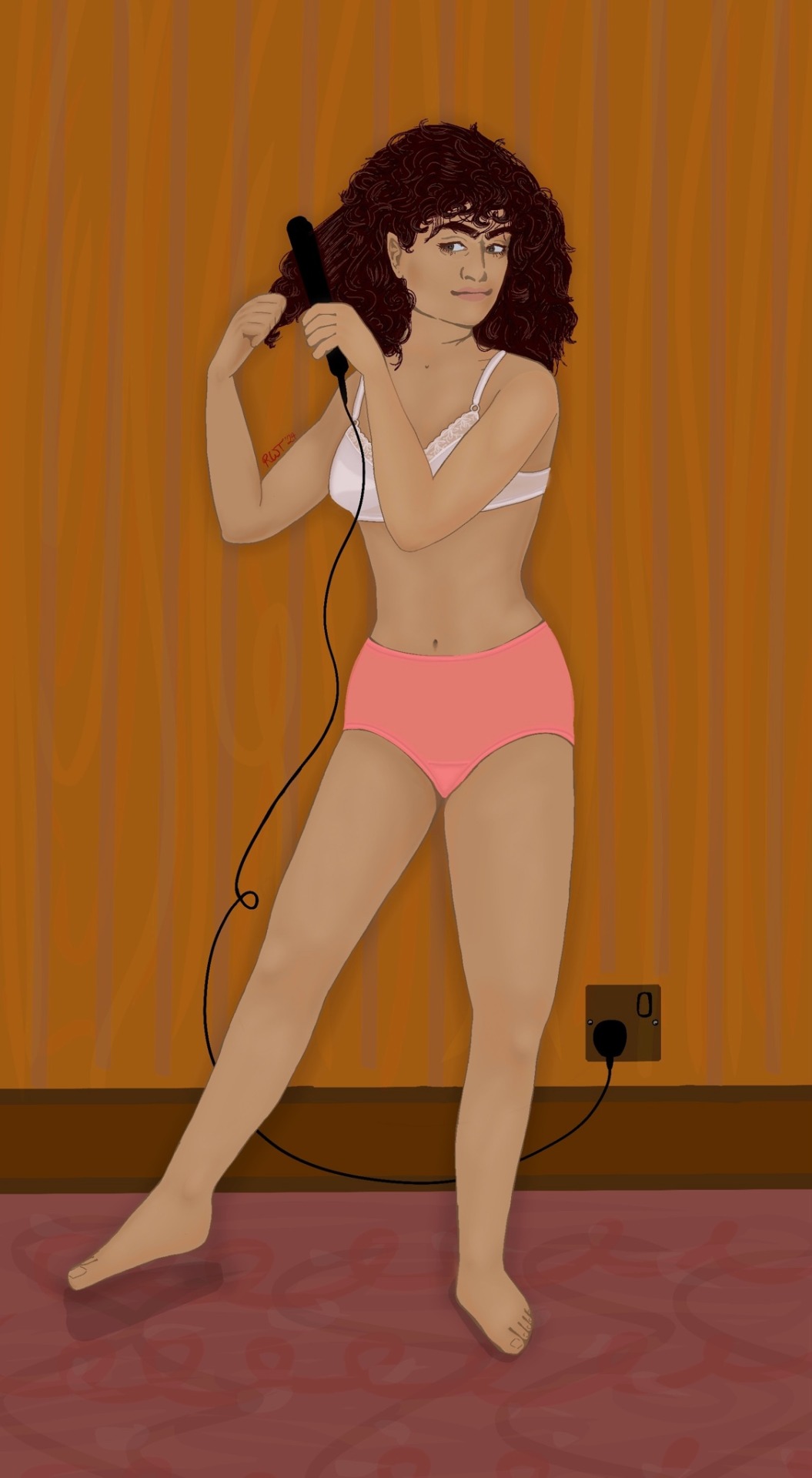
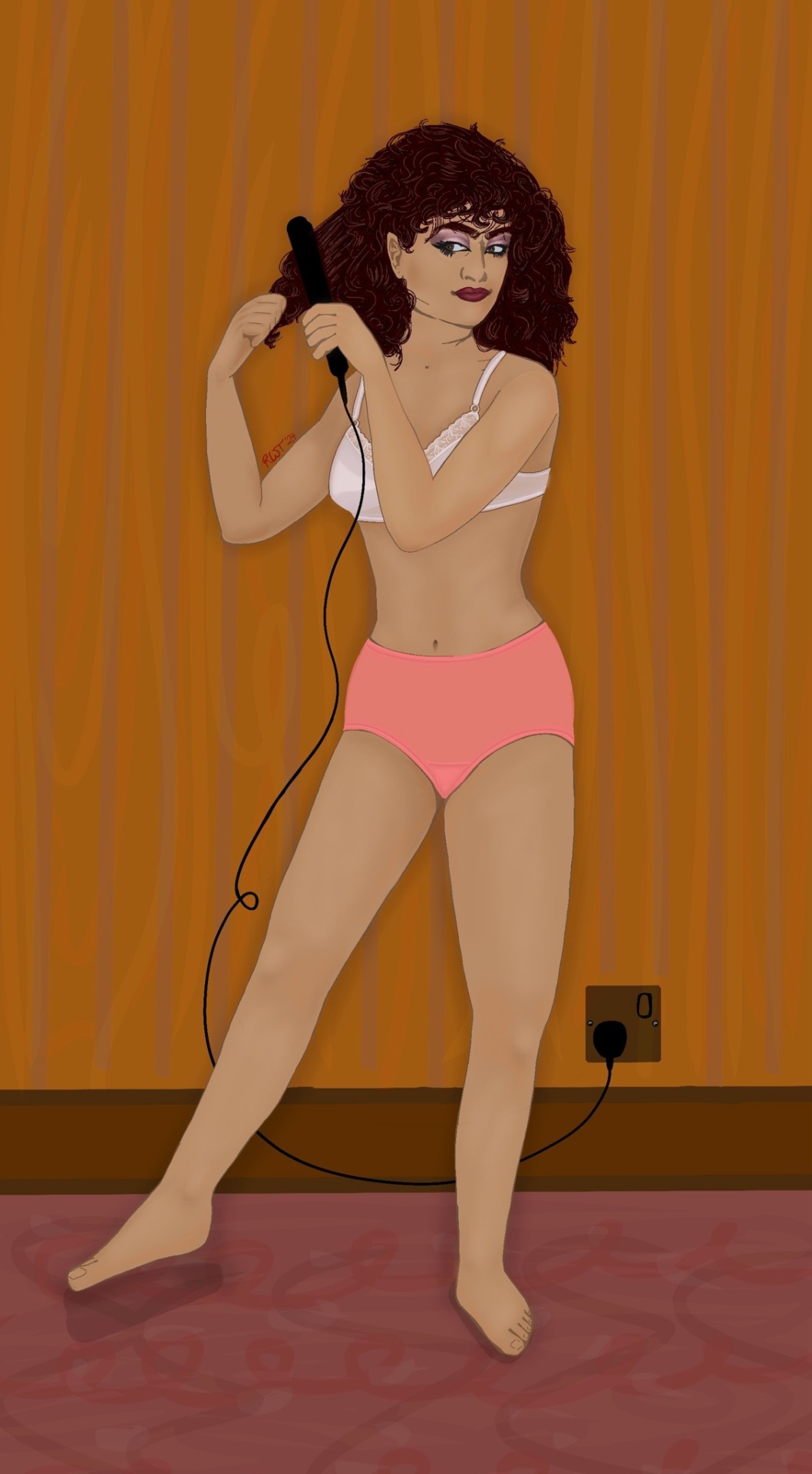
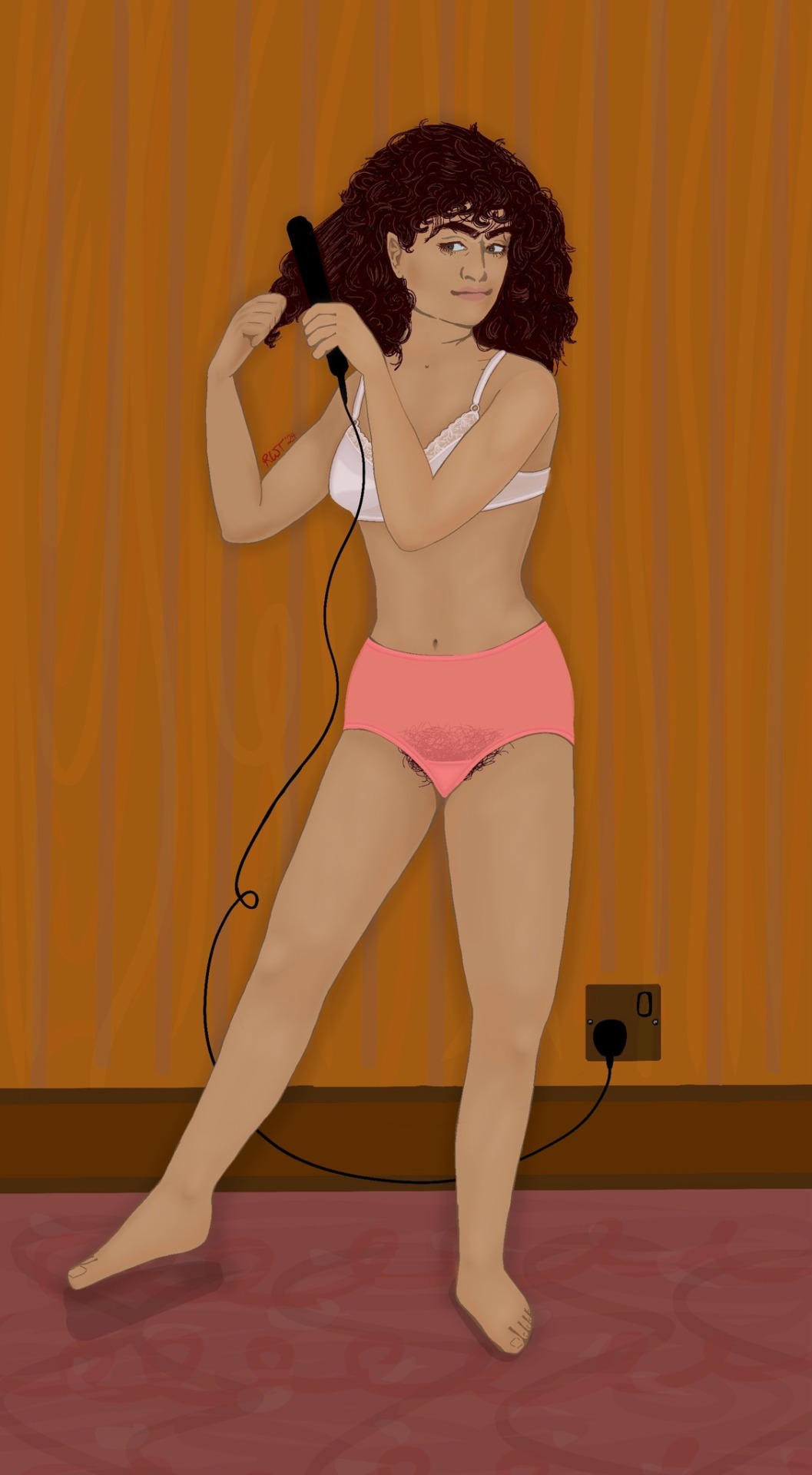
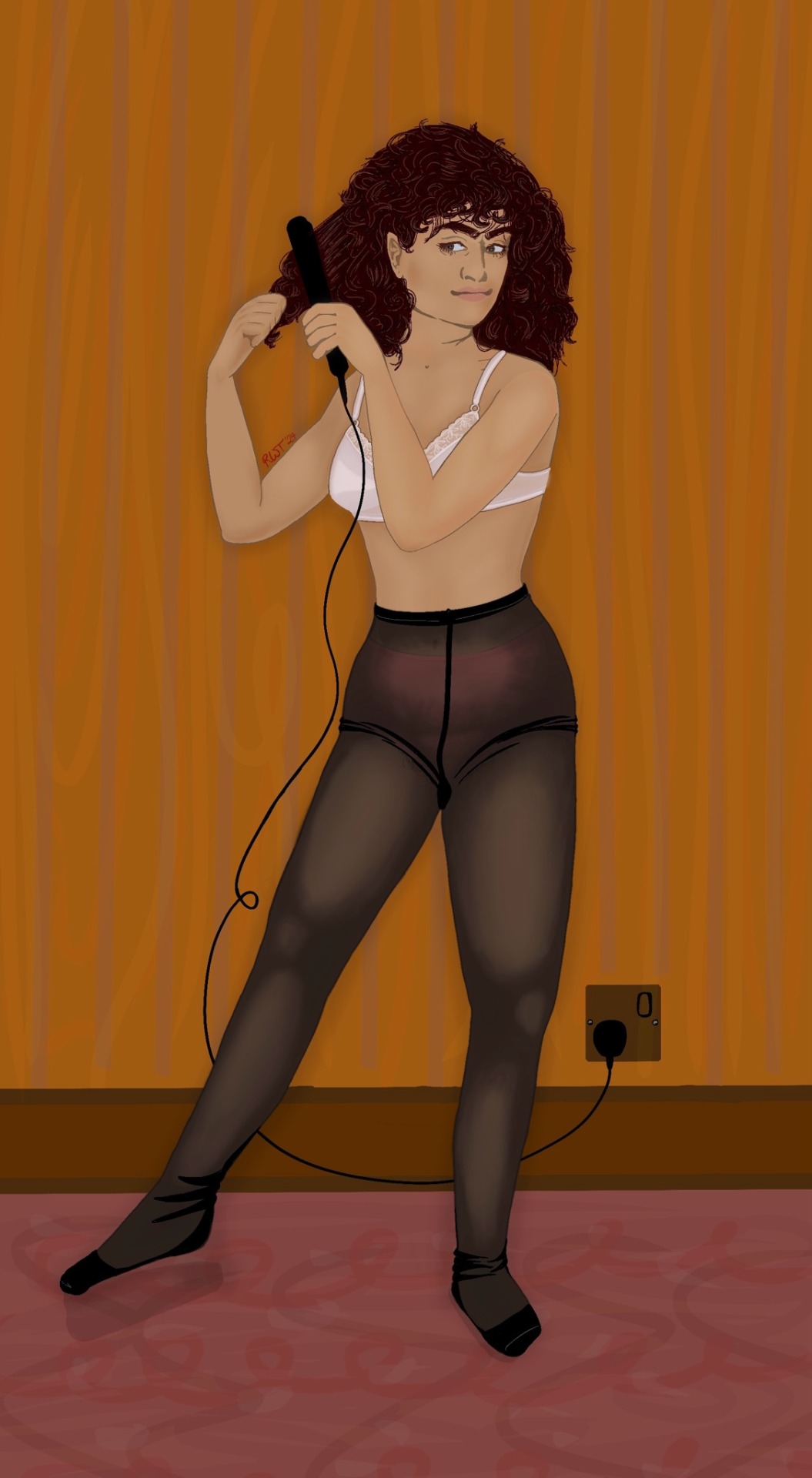
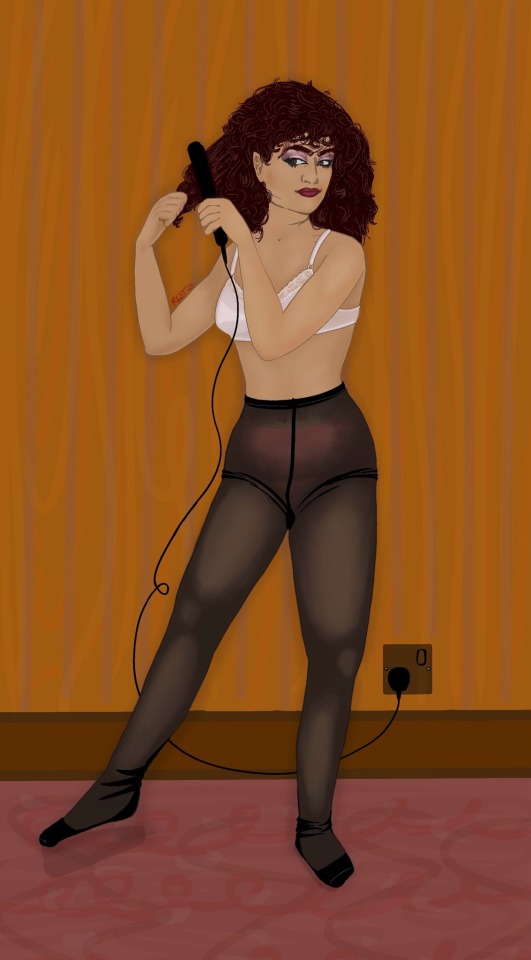

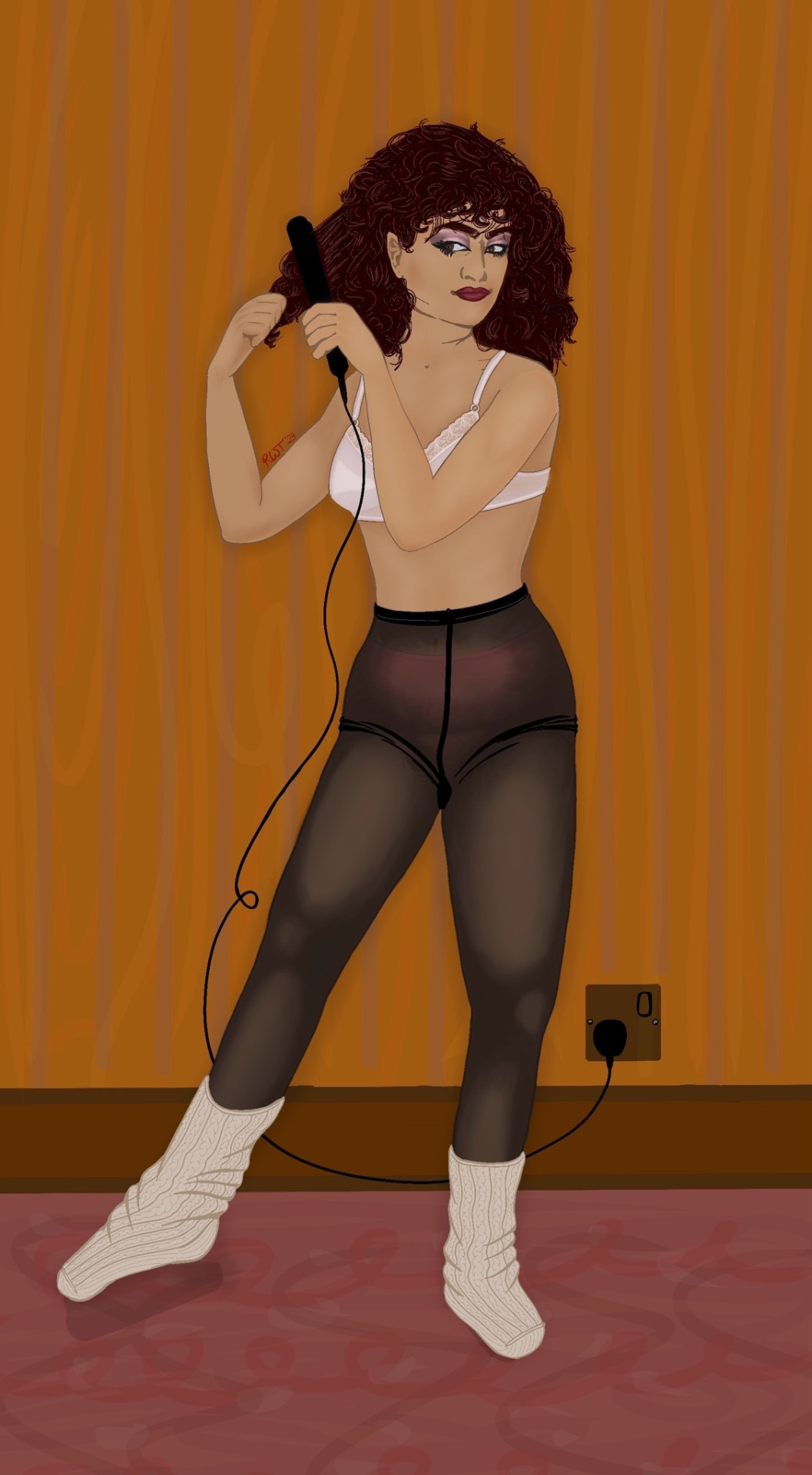
#my art#femme!charles rowland#femme!charlotte rowland#fem!charles rowland#fem!payneland#charles rowland#charlotte rowland#payneland#painland#dead boy detectives#dbda#fanart#charles x edwin#edwin x charles#dbda fanart#the dead boy detectives#dead boy detectives fanart#dead girl detectives#charles rowland fanart#payneland AU#dead boy detective AU#1980s fashion#ska punk fashion#lesbian#femme lesbian#chadwin#genderbend#save dead boy detectives#renew dead boy detectives#dead boy detective netflix
46 notes
·
View notes
Text
how does writing james as south asian change his character?
i've seen a few people discussing this recently—how they don't like the hc because no one seems to account for how much this would change his character.
i agree! i write canon james as indian (usually hyderabadi but there's a few fics where i've changed that) but yea it can be difficult to reconcile him as the popular golden boy in 1970s GB with the racism of 1970s GB. not to say anything about the subconscious racism that often comes with this interpretation of his character.
we never really see james. we see him in snape's and voldemort's memories, and in harry's dementor-induced recollections, not in-person.
there are a few character traits we can pull out: arrogant, clever, athletic, loyal, brave, cruel, self-involved. when i think of james potter i try to imagine what an eton boy would be like if he actually took part in self-reflection. these traits connect to him being popular and talented in a way that makes severus jealous.
he's the masculine ideal. james naturally fit into the idea of a what a man "should be", with the exception of his race if you hc him as south asian. men do not have to be kind, they have to be powerful. his rivalry with someone in a lower class—and it should be noted that severus' main rival is james, not sirius—and his subsequent wins cement his class status.
so, severus and james' rivalry. if you take the canon white, half-blood, working class severus and a hc of south asian, pureblood, upper class james, you have tension between these three markers of status.
my impression of GB society is that class operates cross-generationally, in a way it follows genetics. social class in england (and a lot of parts of south asia) was seen as a marker of your inherent status and worth.
so severus is white, but he's got a muggle dad, he's working class, and he's far from the masculine ideal. james is south asian, pureblood and upper class while being the masculine ideal. their dynamic in this context could be seen as either trying to assert their status, though i think it's severus who is consciously doing this. james just sees most people as less than him and sirius.
severus may also be more jealous of james than sirius because he doesn't think james deserves his status, it should be severus who is raised beyond what his birth entitled him to! severus' ideology is blood supremacist, and though he hates sirius at least sirius acting like he's better than severus is par for the course. it's not as embarrassing as james potter's superiority complex.
but, how did james develop a superiority complex in a world that actively oppresses him? the same way me and my bestie did. meeting young, understanding each other, being naturally intelligent, and having no one else who really gets it. prongsfoot 5eva. james even has an advantage neither of us had, being the only child and being spoiled. open your minds. oppressed people can be arrogant assholes.*
but how did he get popular? this is a better question. honestly, i think charisma, money, and the "rebel" aspect of james made him intriguing to a lot of people.
when it comes to integrating the greater world politics of the period, i hc that due to the collaboration of some upper caste families in india during the colonial period (historical fact) there's a fair amount of south asian wizarding families that have middling status. this makes it easier for him to integrate into the hogwarts social sphere.
the social mores of muggleborns and half-bloods who interact with the muggle world would also be impacted by the multiple civil rights movements of the 60s and 70s. generally young people put on a rebellious, progressive veneer, so this melts into general hogwarts society.
all of this to say, i think james fits the social roles of a pureblood man with a "rebellious" edge that is appealing to young people, and if he is south asian part of that edge is because of his race. that's gross! it's realistic, imo. he doesn't deviate too far from acceptable until he joins the anti-fascist militia. i think most of us understand what it means to be the "acceptable other"
i don't think james being south asian weakens his role in the story as the perfect man. that role is deconstructed, and the contrast of james having more social power in the wizarding world and lily having more social power in the muggle world is interesting to me.
tbh, i've been hc james this way since i was a teenager and didn't think it out until the last few years. i really like the hc but i needed it to make sense to engage with the canon in a complex way.
*this is a joke. i understand that this is complicated and discrimination will always have an impact. i just also think a lot of you see oppressed ppl (esp. poc since this is such a white fandom**) as pure angels and it's weird. most of the ppl making the initial argument at the top of the post are NOT being weird about it
**i am a white american so take what you want from that
36 notes
·
View notes
Text
Axl Low Theory: "His parents were hippies."
Alright, I may not be the person who knows the most when it comes to the game's lore, but this theory is mostly based on some things I noticed that made sense to me. So, please don't take it too seriously; I made it for fun and to share some thoughts.
Also, English isn't my first language so I tried to use some tools so you could understand this sh**
Another thing is READ ALL if you want to understand my point, I know Axl is a British man and hippies were almost americans, I know his parents are rich and they may disinherit him, but please, read 'cause I treat those points in a way or another.
Let’s set the stage with a bit of context:
The hippie movement started in the United States, especially in San Francisco (California), as a reaction against materialism, the Vietnam War, racism, and the social conservatism of the time.
Here are some key values that probably sound familiar to many of you, but let’s refresh them anyway:
☮️-A total rejection of violence and war: The hippies were pacifists through and through.
☮️-Anti-consumerism: They preferred a simpler, more communal life and criticized the growing consumerism of American society.
☮️-Criticism of traditional monogamy and sexual norms, especially those upheld by 1950s American Christianity.
☮️-Interest in Eastern religions, astrology, and mysticism, rejecting mainstream Christianity.
☮️-Respect for nature and a sustainable lifestyle.
☮️-And, of course, the experimentation with drugs like LSD to expand consciousness. (This isn't the most important)
It’s worth noting that this movement wasn’t entirely altruistic. It’s known that many hippies were actually wealthy people who didn’t want to go to war or just wanted to live a carefree, ‘hippie’ lifestyle to escape family pressure. But that doesn’t mean their cause wasn’t legitimate. There were many who genuinely believed in it. Being a hippie doesn't mean you can't be prejudiced and horrible. Besides, people often have ideas when they're young that change when they grow up. Nobody is completely the same thing in their youth compared to their adulthood (30-40)
Also, hippies were persecuted by the police and society during those years. They were often spied on by the FBI under programs like COINTELPRO, aimed at controlling and dismantling countercultural movements. Many also faced discrimination for their appearance, lifestyle, and ideologies.
This led to some of them migrating to rural communes or even to countries like Mexico and India, seeking freedom of worship and less oppressive environments (Or even being prosecuted by the law for drug possession). Some even went to China.
Now, let’s focus on Axl.
No introduction needed; Axl is one of the most iconic characters from the game. He has the unique trait of being a time traveler, specifically from the '90s, which brings me to my first point:
Axl doesn’t quite fit the mentality of the 1990s. The '90s were a time marked by pessimism due to economic and political tensions. This decade saw a rise in sarcasm, satire, and dark humor in media, and entertainment reflected this shift. Think of shows like Ren and Stimpy, the rise of grunge music, comics like Punisher, and video games like Doom. Even kids hated figures that represented positivity, such as Barney.
Axl, on the other hand, stands out for his optimism and his perseverance despite adversity. While he does have his own tragic past, he faces it with humor and constantly strives to be a better person. He’s also a pacifist, always seeking peaceful resolutions, even though he has a history of gang involvement. A pacifist gang member from the '90s? That’s an odd combo.
Now, some might argue that Axl’s background doesn’t quite match the hippie culture. According to the game wiki, Axl comes from a wealthy family but grew up in a dangerous neighborhood in England. This raises a couple of questions:
-Why would wealthy people live in a dangerous area?
-And, if Axl grew up there, why isn’t he more violent like many of the others in his neighborhood?
-Another thing: Axl seems to live simply. His clothes aren’t particularly luxurious, and he eats at places like McDonald’s and hangs out at open-air markets, which suggests a more humble lifestyle. If his family is supposed to be rich, why is he living like that?
You might be asking, "Why are his parents, and not Axl himself, the hippies?"
Well, Axl embodies only a few of the values of the movement, but his parents seem to represent the broader spirit of the hippie culture more directly. Axl is a young adult in the '90s, so he’d likely be between 23-27 years old (I’m guessing he was born between 1971-1975, based on estimates of his age and his time travel experiences). That places him in the 1970s for his childhood, when his parents were likely still deeply influenced by the movement.
(FOR THIS PART, IS NECESSARY FOR ME TO SAY I'M NOT A NATIVE ENGLISH SPEAKER, PLEASE THIS POINT IS ONLY FROM MY LISTENING OF MY SECOND LANGUAGE AND I KNOW I HAVE A BIG PROBABILITY OF SAYING NONSENSE HERE)
Now, here’s the part that might seem a bit weak, but hear me out: Axl’s accent. If you listen closely, you’ll notice that Axl’s English doesn’t quite sound British. It’s more like an American trying to sound British, especially in Strive and XRD. Maybe his parents weren’t British, and Axl grew up with a mixed accent because his parents were from a different place, but the world around him spoke with a British accent.
Now the theory itself:
Axl’s parents could have been a hippie couple who fled the United States during the 1970s. They might have moved to England to escape the oppressive social and political climate in America. I’m suggesting they’re Americans because of Axl’s American-style English, though it’s possible they were British hippies who’d returned to the UK after their time in Asia with other hippie communes.
They likely decided to settle down in the 1970s when they found out they were having a child. True to their hippie values, they chose to live in a poor, rundown neighborhood, away from the luxuries they could afford. However, they made sure Axl didn’t want for anything materially. More importantly, they instilled in him their values without forcing him into a particular path in life, allowing him the freedom to choose his own.
Growing up in such a neighborhood, Axl witnessed the violence and struggle around him, which only strengthened his commitment to his parents’ pacifist ideals. He likely heard stories of the persecution his parents faced, and perhaps this inspired him to act and try to bring peace to his community.
With all this in mind, I believe the environment in which Axl grew up played a big role in shaping who he became. His parents’ influence is clear, but the place he lived and the experiences he had contributed just as much to his growth. But of course, they only believed in this part of their cause, they might have changed their mind living in London and maybe they never believed in all of this and only looked for easy drugs, being that the reason or their persecution, or were a bit classist and racist, that's why they rejected Axl when he decided to live his life with Megumi.
Well, that's all guys, hope you like it... Don't take me seriously please, I say this only from the perspective of a weird stupid fan of Axl Low, i know this may be more a headcanon than a theory itself qwq

17 notes
·
View notes
Text
Robe à la Française
French, ca. 1770

The robe à la française, with open robe and petticoat, was the quintessential dress of the eighteenth century. Characteristic of 1770s costume are the piece's low neckline, fitted bodice, narrow sleeves with double layered cuffs, as well as the sack back and fullness at the hips supported by panniers. This exquisite example is constructed from a rare Chinese export silk dating from the first quarter of the eighteenth century. The textile is an ivory "bizarre" patterned damask (created by reversing the weave structure so that both the warp-float and weft-float faces of the satin are on the same surface).
As early as the late sixteenth century, Chinese craftsmen created silks for the European market, which were exported by the East India companies of England, France, and Holland. Due to the exchange of design motifs by both Eastern and Western artisans, Chinese export silks often bore little relation to traditional Chinese aesthetics. While this patterned damask closely resembles the European "bizarre" silks popular during the first quarter of the eighteenth century, the selvedge-to-selvedge width, fabric weight, and selvedge markings all indicate Chinese manufacture. To fully appreciate the sumptuousness of this dress, one might imagine the sense of movement candlelight would have created across its surface.
The MET Museum
209 notes
·
View notes
Text
A really silly enchanted Nemo (he's been turned into a tiger!) ficlette that I wrote instead of doing work:
Keeping Monsieur, recently made Professor, Aronnax from harm during research trips was a much larger part of Conseil's job than the one would expect from the title of 'Valet'. Most days Aronnax would be so focused on making notes that he would wander into dangerous zones or his curiosity would get the better of him and he would stray off the recommended paths to study something up close.
Today was one of those days.
"It looks injured Conseil!"
The 'it' in question was a tiger, which Aronnax seemed desperate to help.
"Monsieur, approaching a wild tiger, especially one in pain, may be unwise."
Despite his attempts to deter the other man he knew his words were falling on deaf ears.
"Looks like it's caught in a hunters trap." Aronnax frowned unhappily, "I overheard some of the British men at the base talk about tiger hunting..I did not think they were actively doing so."
Conseil sighed, the Professors idealism would get him in serious trouble one day..strike that Conseil thought as he witnessed his friend climb over the fence, it was going to get him in trouble this very day.
It looked to be a bear trap of sorts. The tiger was trying to escape but it's movements seemed less frantic than earlier, likely from the blood loss he mused as he took in the pools of blood around the creature.
As one might approach a scared cat Pierre spoke in a low, soothing voice.
"I am not going to hurt you." He kept his approach slow, "I am a doctor. I am going to free your leg."
The tiger snarled but did not make to attack. While he spoke the tigers eyes seemed to follow his words with what Pierre felt was an almost human intelligence - how strange?
Conseil arrived in time to hear his Monsieur introduce himself to the feline as if it were a person. In a less intense and dangerous scenario the man telling a tiger he was a published professor might have been comical; but, as it stood, Conseil felt nothing but trepidation.
Finally Pierre reached the trap. The tiger still hadn't attempted to attack him.
"This is going to hurt, my friend."
For a moment Pierre thought the tiger nodded at him. But that wouldn't be possible, right? That would require an understanding of French, which was highly unlikely for a tiger in India.
Skillfully Pierre disassembled the trap. The tiger and growled and flinched but not struck him.
Ever the doctor Pierre began to tend to the creatures wounds. "Poor you. What did they do to you."
Conseil started to come closer, to assist the Professor, but as he came closer the tiger snarled at him.
When the tiger had layed it's head back down Conseil attempted to approach again.
Again the tiger growled threateningly at the man.
"None of that now" Pierre reprimanded while stroking his flank, "that's Conseil; he's my assistant and friend."
As the tiger turned to look at him, Pierre wagged his finger, "he's not going to hurt you either, so be nice - no growling."
With a harrumph the tiger lay his head back down, were Conseil in anyway prone to whimsey he might have imagined the creature looked a little irritated.
Time passed; Conseil watched as the Professor wasted medical thread and other products on the tiger while talking gently to the large cat as if it were a person, or at least a house cat.
"There we go." Pierre stood up, crunching noises accompanying his stretch, "find some nice spot to rest a while and you will be fighting fit in no time."
"Come, Conseil, let us head back or they might start looking for us and I don't fancy arguing with those British men again, I have far better things to do with my time."
The tiger made an unusual noise, one that sounded almost like a scoff or suppressed laugh.
Again, Pierre found himself unsure about the tiger and it's human like behaviour.
"As Monsieur wishes. May I take your bag?"
"Of course, thank you." Pierre turned back to the tiger, "well, my furry friend, I wish you the best of luck with your injury. Farewell."
As Pierre made to leave the creature let our a whine, similar to a cat but much deeper, looking up at the Professor with pleading eyes.
"I'm sorry, but I have to go." He crouched by the tiger's head, scratching his ears. "And you should find somewhere safer."
To the detriment of Conseil's cardiovascular health Pierre leaned forward and pressed a kiss on the side of the tigers maw.
The impossible happened instantaneously.
One moment Aronnax had his hand in the fur of an exceptionally docile tiger and the next he made contact with very much human skin.
"Huh?!"
Pierre's eyes widened as he took in the, exceptionally handsome, man beneath him.
The man stared back at him.
"You are not a tiger?" Pierre whispered.
"No."
Taking a moment to look over the man Pierre realised something and flushed a bright red.
"However; I am naked."
Immediately the Professor looked at the ground as far away from the man as possible, flushed to the very tips of his ears.
Conseil resisted the urge to look up at the sky and ask the heavens how he ended up here.
Oh, and apparently magic exists - adding a whole new dimension of things that he would have to protect Monsieur Aronnax from.
#idk why i wrote this but i had fun#tkluts#twenty thousand leagues under the sea#pierre aronnax#20000 leagues under the sea#captain nemo#aronnemo#nemonnax#nemonax#conseil#nautilus#professor aronnax
12 notes
·
View notes
Text
𝙼𝚒𝚛𝚛𝚘𝚛, 𝙼𝚒𝚛𝚛𝚘𝚛, 𝙾𝚗 𝙼𝚢 𝙼𝚒𝚗𝚍: 𝙰 𝚁𝚊𝚠 𝙳𝚒𝚟𝚎 𝙸𝚗𝚝𝚘 𝙱𝚘𝚍𝚢 𝙸𝚖𝚊𝚐𝚎



Chapter 1:
The First Time You Realized Your Body Was Being Watched
It starts young. For some, it’s the aunt who pinches your cheeks and tells you not to eat too many laddoos or you'll get “healthy.” For others, it’s the media showing you that "hot" means size zero, thigh gaps, flawless skin, abs, and hip bones that look like weapons. It doesn’t matter if you’re in India or Iceland—the world’s obsession with the “ideal body” finds you.
Suddenly, you’re no longer just living in your body. You’re managing it. Editing it. Apologizing for it. Dressing it to make it look “smaller,” “bigger,” “curvier,” “slimmer.”
You’re performing.
And no one handed you a script, but you knew what your role was supposed to be:
Be beautiful. But make it effortless. And definitely don’t complain.
Chapter 2:
The Inner Critic is Loud, Rude, and Always Online
Body image isn’t just what you see in the mirror—it’s the perception you’ve built over years, influenced by family, media, comparison, and let’s be honest, trauma.
It’s not always rational. It doesn’t care if you’re healthy. It doesn’t care if people compliment you. Body image is what you tell yourself when no one is watching.
It’s the whisper that says, “You’d be prettier if…”
It’s the scroll through social media that ends in, “Why don’t I look like that?”
It’s the photo you untag, the angle you avoid, the clothes you won’t wear even though you love them.
And it’s exhausting.
Because every single day, you’re trying to negotiate with a part of your brain that was never meant to be your enemy.
Chapter 3:
The Body Isn’t the Problem. Society’s Lens Is.
Let’s be real: standards change faster than fashion trends. What was “in” in 2005 is now demonized. Remember heroin chic? Now we want “slim thick.” The Kardashians switched from promoting waist trainers to doing pilates in Paris.
The goalposts of beauty are constantly shifting—and we’re made to feel like we are the problem for not keeping up.
Capitalism thrives on your insecurity.
So does the fitness industry, the fashion world, even some doctors.
But your body is not a trend. It’s not an aesthetic. It’s the vessel that carries you through life. It breathes, creates, heals, fights, holds trauma, holds joy, and holds memories. It’s sacred. It’s yours.
Chapter 4:
Healing Isn’t Linear (And Sometimes It’s a Damn Rollercoaster)
Let’s not pretend this is easy. You can do mirror affirmations, unfollow every model on Instagram, and still have days where you feel like garbage. That’s okay. Healing body image is like decluttering a house you’ve lived in for decades. You’re bound to find some dust.
Here’s what helps, even when you don’t believe it yet:
• Speak to yourself like you would to a friend.
If you wouldn’t call your bestie a “fat failure,” don’t say it to your damn self.
• Stop waiting to live your life.
Wear the outfit. Take the picture. Swim in the pool. Dance at the wedding. You don’t need to “earn” joy.
• Curate your feed.
If someone’s posts make you feel like trash, mute them. Replace with body-neutral, diverse, or joyful creators.
• Get back into your body.
Dance, stretch, walk, do yoga, breathe. Not to burn calories—but to connect with this beautiful, bizarre, resilient machine that is your body.
• Therapy.
Honestly, if you can access it, therapy is gold. Especially if you deal with disordered eating or body dysmorphia. You don’t have to carry this alone.
Chapter 5:
Body Positivity vs. Body Neutrality vs. Body Liberation
Let’s decode these real quick:
Body Positivity says: Love your body no matter what.
But some days, that feels fake, right?
Body Neutrality says: You don’t have to love it, just respect it.
It’s more chill, more sustainable.
Body Liberation says: Your worth has NOTHING to do with how your body looks. Let’s dismantle the whole system.
It’s the revolutionary big sister of the movement.
Pick whatever feels right. You don’t have to force joy every day. Some days survival is the victory.
Chapter 6:
Your Body Isn’t Ruined—It’s Lived In
Stretch marks? Life happened.
Cellulite? Literally 90% of women have it.
Acne, scars, bloating, belly rolls? Baby, those are human features, not flaws.
Your body doesn’t need to be smaller, smoother, tighter, or “corrected” to be beautiful. You’re not a before-and-after story. You’re a full damn novel.
And newsflash: you’re already enough.
Right now.
Without the glow-up. Without the transformation reel. Without the filter.
Chapter 7:
The Delulu Ending (That’s Lowkey Realistic Too)
Imagine this:
You wake up, look in the mirror, and smile—not because you look perfect, but because you look like you. You put on clothes that feel like freedom. You take photos and don’t overthink the angles. You eat what you want, move how you want, love who you want, and stop giving a damn what people think of your body. You realize the world lied to you—but now you’re reclaiming the truth.
That kind of peace? It’s not delusional.
It’s the most rebellious thing you can do.
Final Word from Someone Who’s Also Working On Herself:
Body image isn’t a destination. It’s a relationship. Some days you fight, some days you flirt, some days you hold hands and strut through life like the icons you are.
Just don’t ghost yourself in the process.
You’re not a project.
You’re a f**king masterpiece. In progress. With glitter.
#aesthetic#dream life#empowerment#girlblogging#love#it girl#manifesation#manifesting#self care#gaslight gatekeep girlboss#selflove#self help#self improvement#skincare#subliminals#better living#better life#empower yourself#manifestationmagic#manifestation#girl boss gaslight gatekeep#bodytexture#body posititivity#becoming that girl#tumblr girls#its a girl blog#self love aesthetic#main character#being a woman#body image
19 notes
·
View notes
Text
Even if you are celibate, you want to still have access to arousal in your body instead of numbed out. You still want to have connection to your orgasmic range as well. I also know it's tender thing too because we weren't necessarily taught to think of arousal or orgasm beyond being in relationship to men or a lover. That's the huge shadow I'm seeing buried in the female psyche that hinders us in accessing deeper mysteries. We are literally the only mammal on the planet who has an organ whose sole function is pleasure: the clitoris. I want to be pristinely clear though that when I speak about "arousal" or "orgasmic range," I'm not necessarily talking about sex with a lover. I am, however, speaking the primal truth of the divine nature of a healthy female body and how it functions best--with orgasmic arousal energy flowing throughout from root to crown, whether due to seeing a stunning sunset over the wild horizons of South Africa, feeling the seat of the machine move deeper into your body while doing seated calf raises at the gym, or taking your time while making sourdough bread or incredible love with your Beloved lover. What's important to emphasize is that when you have high arousal or a large orgasmic capacity, you also have an enlarged amount of creative energy. Even if you are celibate, you have to transmute this energy beyond chronically masturbating, moving it up your spine and turning it into spiritual energy to manifest the most incredible ideas, next step directions, and advanced intuition. With celibacy, a movement practice is essential so that your energy doesn't pool or become too dense or heavy. And masturbation is fine, but too much masturbation drains your chi. You need art, hobbies, skills like learning a new language, fitness, creative projects, entrepeneurship, music, dance lessons, and the like. -India Ame'ye, Author
140 notes
·
View notes
Text
HUgE Jan 2011
FLYMYJEAN (pt.2 finale)
Denim always reflects the wearer’s style. Whether you want to look tough and manly or elegant, get the best denim to define your style!

MAISON MARTIN MARGIELA
This season's theme is old black and white photography
The irregular grey melange created by pleating represents this abstract image. ¥49,350 Maison Martin Margiela, Tokyo
BALMAIN Homme
The classic biker pants have a refined, elegant design that is more sophisticated than their original hard look. They are perfect for a sophisticated outfit.
¥147,000 (Edition Omotesando Hills store)
DIESEL BLACK GOLD
We spent a lot of time and effort on hand-crafted techniques such as stone washing, scratching, and applation to create a more realistic texture.
¥40,950 (Diesel Japan)

THOM BROWNE
The first denim collection from Thom Browne. Check out the tricolor tab on the back yoke and the tag on the left leg, which are typical of Thom Browne. ¥36,750 (Steady Study)
GARETH PUGH
A bold design made from denim patchwork. The stoic nature of the design omits pockets and functionality.
It's very clean and original. ¥72,450 (International Gallery Beams)
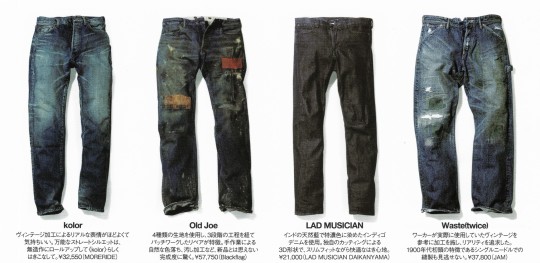
HYSTERIC GLAMOUR
The torn parts of the denim are remade by patching them with sweatshirts featuring original prints. The design combines hard and pop styles for a playful feel.
¥48,300 (Hysteric Glamour)
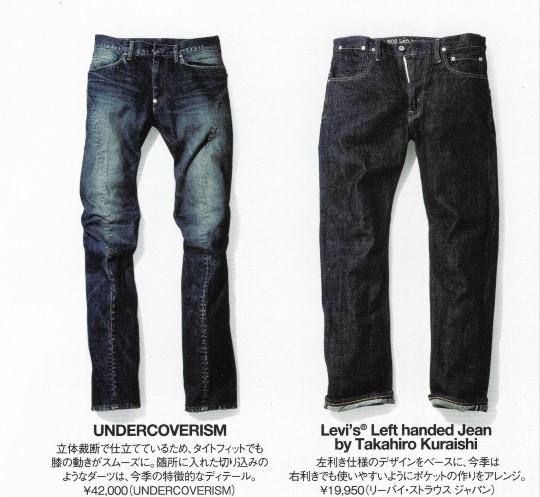
kolor
The vintage processing gives it a realistic look that feels just right. The versatile straight silhouette can be casually rolled up for a (kolor)-like look. ¥32,550 (MORERIDE)
Old Joe
The item is made of four different fabrics and has been patchwork repaired in three stages. The natural fading and dirtiness of the hand-made finish makes it hard to believe it is brand new. ¥57,750 (Blackflag)
LAD MUSICIAN
Made from indigo denim dyed in a deep color using natural indigo from India. The unique cut 3D shape gives it a slim fit yet comfortable feel.
¥21,000 (LAD MUSICIAN DAIKANYAMA)
Waste(twice)
The fabric was processed based on vintage items actually worn by workers, in pursuit of realism. Don't miss the single-needle stitching, a feature of the early 1900s. ¥37,800 (JAM)
UNDERCOVERISM
The three-dimensional cut allows smooth knee movement even with a tight fit. The darts that look like slits are a distinctive detail for this season.
¥42,000 (UNDERCOVERISM)
Levi's® Left handed Jean by Takahiro Kuraishi
Based on a left-handed design, this season the pockets have been redesigned to make them easier for right-handed people to use as well.
¥19,950 (Levi Strauss Japan)
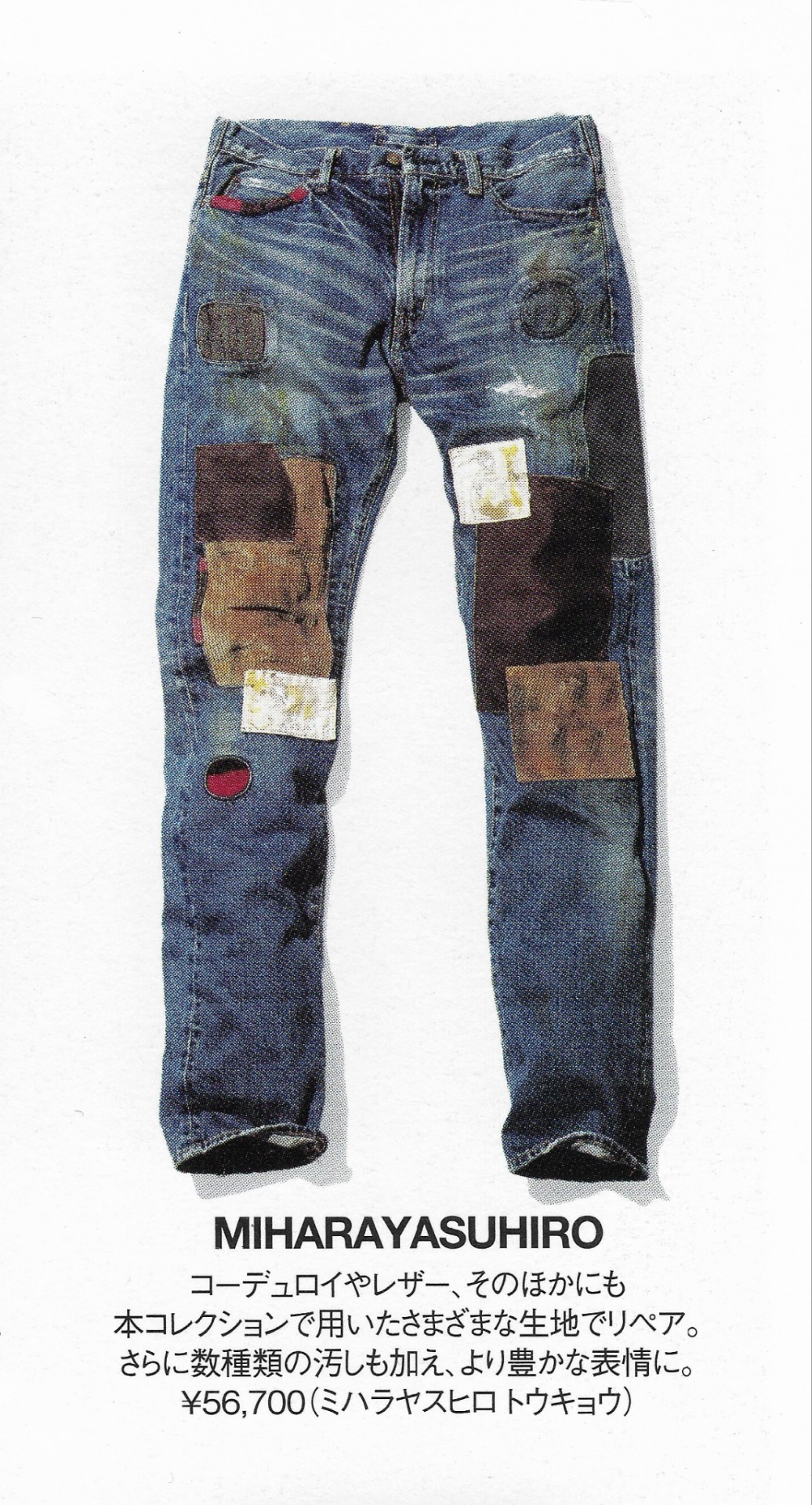
SASQUATCHfabrix. Chilling
The corduroy switching at the knees is the highlight.
The same material is used to create a jacket with elbow panels, so you can wear it as a set.
¥24,150 (Nepenthes Tokyo)

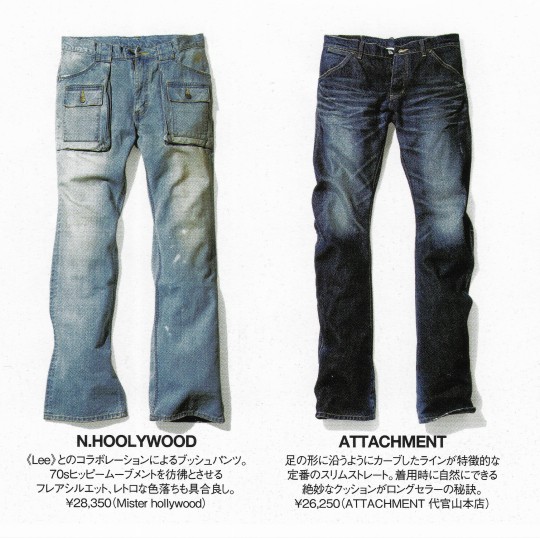
MIHARAYASUHIRO
Corduroy, leather, and more
Repairs were made using various fabrics used in this collection.
Several types of dirt have also been added to give it a richer look.
¥56,700 (Miharayasuhiro Tokyo)
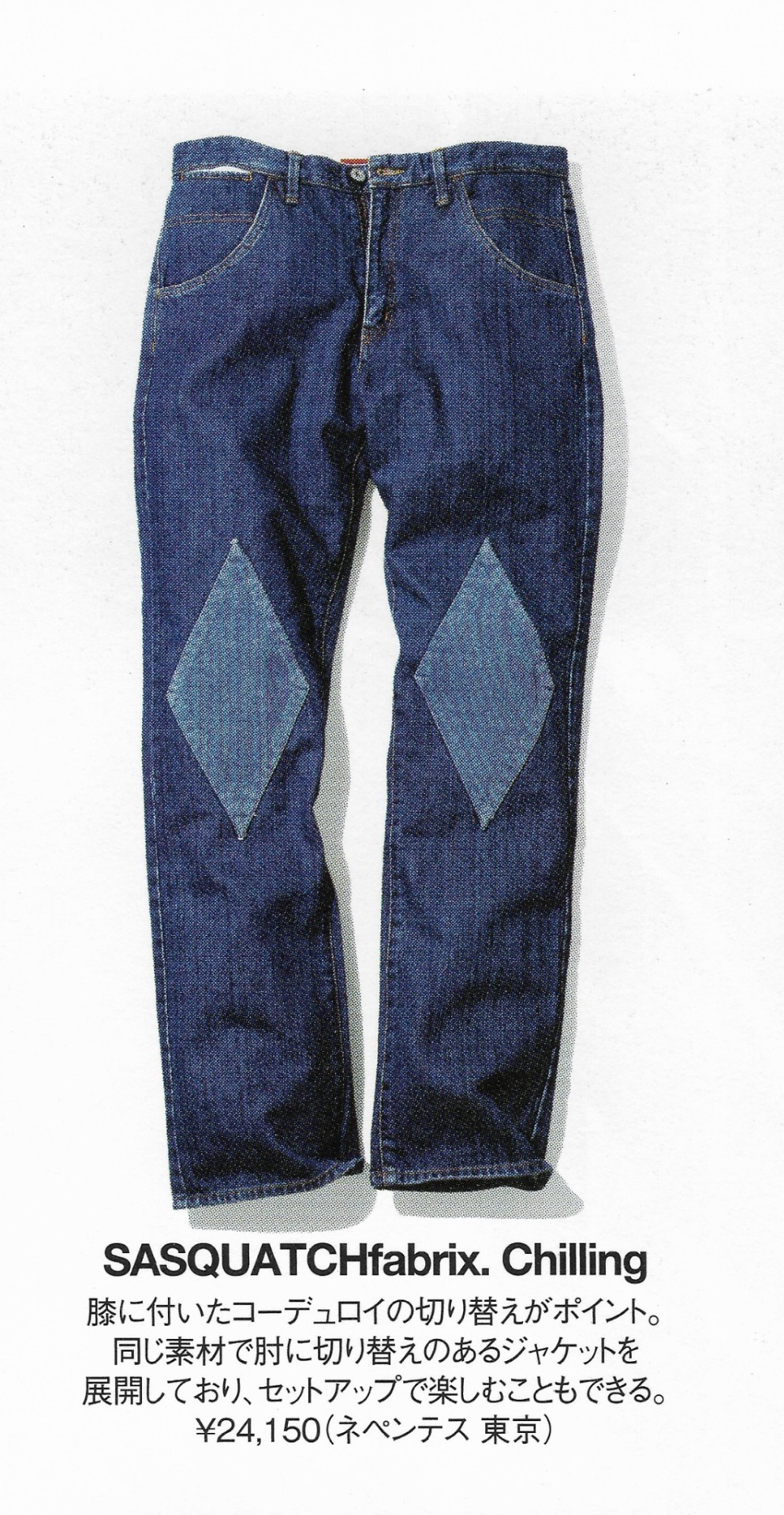
A.P.C.
It features a natural texture that has been worn for many years. The repair stitching that matches the fading of the denim, the ink stains on the pockets, and other fine details are also attractive. ¥29,400 (A.P.C. Customer Service)
Levi's®× WACKO MARIA
A dream collaboration with Levi's® has come true. The silhouette is an original (Wacko Maria) design, with a special edition patch with "GUILTYPARTIES" engraved on it. ¥33,600 (Blackflag)

N.HOOLYWOOD
Bush pants in collaboration with <Lee>. The flared silhouette is reminiscent of the 70s hippie movement, and the retro faded color is also nice. ¥28,350 (Mister Hollywood)
ATTACHMENT
The classic slim straight style features curved lines that follow the shape of your foot. The exquisite cushioning that is created naturally when worn is the secret to its longevity.
¥26,250 (ATTACHMENT Daikanyama main store)
#my scans#fashion#avantgarde#2010s fashion#archive fashion#japanese fashion#gareth pugh#wacko maria#apc#mihara yasuhiro#nepenthes#undercover#jun takahashi#levis jeans#takahiro miyashita#kolor#hysteric glamour#thom browne#diesel jeans#maison martin margiela#balmain#christophe decarnin#denim jeans#denim#distressed
9 notes
·
View notes
Text
2024 Book Review #27 – From the Ruins of Empire: The Revolt Against the West and the Remaking of Asia by Pankaj Mishra
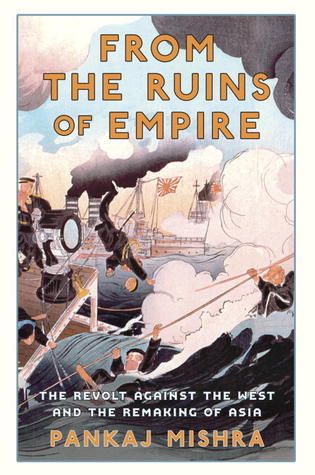
Yet another work of nonfiction I picked up because an intriguing-sounding quote from it went viral on tumblr. This was the fifth history book I’ve read this year, but the first that tries very consciously to be an intellectual history. Both an interesting and a frustrating read – my overall opinion went back and forth a few times both as I read and as I put together this review.
The book is ostensibly a history of Asia’s intellectual response to European empire’s sudden military and economic superiority and political imperialism in the 19th and 20th centuries, though it’s focus and sympathy is overwhelmingly with what it calls ‘middle ground’ responses (i.e. neither reactionary traditionalism nor unthinking westernization). It structures this as basically a series of biographies of notable intellectual figures from the Islamic World, China and India from throughout the mid-late 19th and early 20th centuries - Liang Qichao and Jamal al-Din al-Afghani get star bidding and by far the most focus, with Rabindranath Tagore a distant third and a whole scattering of more famous personages further below him.
The central thesis of the book is essentially that the initial response of most rich, ancient Asian societies to sudden European dominance (rung in by the Napoleonic occupation of Egypt and the British colonization of India) was denial, followed (once European guns and manufactured goods made this untenable) by a deep sense of inferiority and humiliation. This sense of inferiority often resulted in attempts by ruling elites and intellectuals to abandon their own traditions and westernize wholesale (the Ottoman Tanzimat reforms, the New Culture Movement in China, etc), but at the same time different intellectual currents responded to the crisis by synthesizing their own visions of modernity, and tried to construct a new world with a centre other than the West.
I will be honest, my first and most fundamental issue with this book is that I just wish it was something it wasn’t. Which is to say, it is a resolutely intellectual and idealist history, convinced of the power of ideas and rhetoric as the engine for changing the world. Which means that the biography of one itinerant revolutionary is exhaustively followed so as to trace the evolution of his world-historically important thoughts, but the reason the Tanzimat Reforms failed is just brushed aside as having something to do with europhile bureaucrats building opera houses in Istanbul. Not at all hyperbole to say I’d really rather it was actually the exact opposite – the latter is just a much more interesting subject!
Not that the biographies aren’t interesting! They very much are, and do an excellent job of getting across just how interconnected the non-Western (well, largely Islamic and to a lesser extent Sino-Pacific) world was in the early/mid-19th century, and even moreso how late 19th/early 20th century globalization was not at all solely a western affair. They’re also just fascinating in their own right, the personalities are larger than life and the archetype of the globe-trotting polyglot intelligentsia is one I’ve always found very compelling. While I complain about the lack of detail, the book does at least acknowledge the social and economic disruptions that even purely economic colonialism created, and the impoverishment that created the social base the book’s subjects would eventually try to arouse and organize. And, even if I wish they were all dug into in far more detail, the book’s narrative is absolutely full of fascinating anecdotes and episodes I want to read about in more detail now.
Which is a problem with the book that it’s probably fairer to hold against it – it’s ostensible subject matter could fill libraries, and so to fit what it wants to into a readable 400-page volume, it condenses, focuses, filters and simplifies to the point of myopia. Which, granted, is the stereotypical historian’s complaint about absolutely anything that generalizes beyond the level of an individual village or commune, but still.
This isn’t at all helped but the overriding sense that this was a book that started with the conclusion and then went back looking for evidence to support its thesis and create a narrative. Which is a shame, because the section on the post-war and post-decolonization world is by far the sloppiest and least convincing, in large part because you can feel the friction of the author trying to make their thesis fit around the obvious objections to it.
Which is to say, the book draws a line on the evolution of Asian thought through trying to westernize/industrialize/nationalize and compete with the west on it’s own terms (in the book’s view) a more authentic and healthy view that rejects the western ideals of materialism and nationalism into something more spiritual, humane, and cosmopolitan, with Gandhi kind of the exemplar of this kind of view. It tries to portray this anti-materialistic worldview as the ideology of the future, the natural belief system of Asia which Europe and America can hope to learn from. It then, ah, lets say struggles to to find practical evidence of this in modern politics or economics, lets say (the Islamic Republic of Iran and Edrogan’s Turkey being the closest). It is also very insistent that ‘westernization’ is a false god that can never work, which is an entirely reasonable viewpoint to defend but if you are then you really gotta remember that Japan/South Korea/Taiwan like, exist while going through all the more obvious failures. One is rather left feeling that Mishra is trying to speak an intellectual hegemony into existence, here. (The constant equivocation and discomfort when bringing up socialism – the materialistic western export par excellence, but also perhaps somewhat important in 20th century Asian intellectual life – also just got aggravating).
It’s somewhere between interesting and bleakly amusing that modernity and liberal democracy have apparently been discredited and ideologically exhausted for more than one hundred years now! Truly we are ruled by the ideals of the dead.
I could honestly complain about the last chapter at length – the characterization of Islam as somehow more deeply woven in and inextricable from Muslim societies than any other religion and the resultant implicit characterization of secular government as necessarily western intellectual colonialism is a big one – but it really is only a small portion of the book, so I’ll restrain myself. Though the casual mention of the failures of secular and socialist post-colonial nation-building projects always just reminds me of reading The Jakarta Method and makes me sad.
So yeah! I felt significantly more positively about the book before I sat down and actually organized my thoughts about it. Not really sure how to take that.
#book review#history#From the Ruins of Empire#From the Ruins of Empire: The Revolt Against the West and the Remaking of Asia#Pankaj Mishra
28 notes
·
View notes